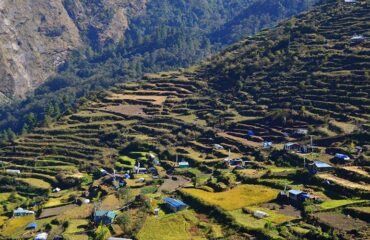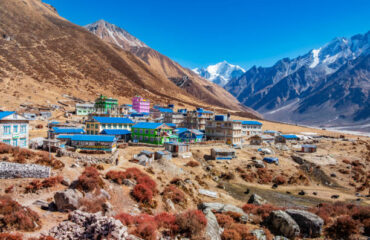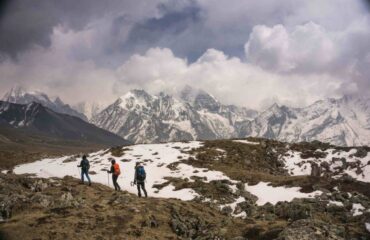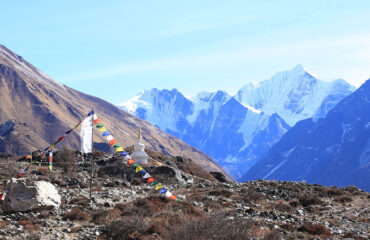Langtang Valley Trekking
fromEmbark on the Closest trek to the Kathmandu Valley and trek in Langtang amid cultural immersion with Tamang ethnic communities.
-
Reviews 0 Reviews0/5
-
Vacation Style Holiday Type
-
Hiking
-
Mountain
-
-
Activity Level Moderate
-
Group Size Medium Group
The Langtang Valley trek is a trek with real heart. The Langtang Valley is one of the most beautiful places in Nepal and was once the darling of trekkers seeking stunning landscapes and authentic culture along with heartwarming hospitality in delightful homestay guest houses all within easy reach of Kathmandu. Langtang Valley is the nearest Himalayan Region from Kathmandu valley, few hours drive from Kathmandu will take you to the beautiful Langtang region. Despite being very close to Kathmandu, the Langtang Region is as wild as any Tibetan highlands with an idyllic rural landscape.
The Langtang Valley has long been a favorite trek due to its expansive views, interesting Tamang culture, relatively gentle pace and accessibility from Kathmandu. The 2015 earthquake and subsequent landslide had an enormous effect on the region, but aid and reconstruction have recently reopened this valley to trekking again. Not only is it still a beautiful trek, your visit will also provide vital support for local livelihoods.
This trek is an excellent trek if you are a little short on time or are nervous of starting on one of our longer, higher altitude expeditions. Despite being shorter, the Langtang trek captures all the best of Himalayan trekking with stunning scenery and fascinating culture.
Trip Highlights
- One of the world’s most beautiful valleys.
- The superb short trek destination.
- Pass through stunning forests, high alpine meadows, and yak pastures.
- Varied vegetation and mixed landscapes.
- Visit of the local Cheese Factory in Kyanjing Gompa
- Enjoy panoramic views across vast open valleys at the end of the trek
- Experience the rich cultural exploration of the local people in the Himalayas
- Airport transfers and escort.
- All meals while on the trek. (Breakfast, Lunch, Dinner, Tea, Coffee, Hot beverage)
- Accommodation during your whole trip at local lodges.
- Transportation to and from Kathmandu to trek starting point as mentioned on itineraries.
- English speaking government-licensed Sherpa guide.
- Porter Service (2 trekkers = 1 porter)
- Staff cost including their (Salary, equipment, food, accommodation, and insurance )
- Assistance Sherpa guides as required
- National park fees.
- All permits to enter the local municipality and Langtang national park
- 3 nights accommodation at tourist standard category hotel in Kathmandu with breakfast on twin sharing basis
- All guided sightseeing tours in Kathmandu and entry fees.
- All ground transportation on comfortable private vehicle
- All government and local taxes
- International airfares
- International Airport Departure Tax and visa fees
- Personal and Trekking Equipment
- Major meals, Lunch, and dinner during your stay in Kathmandu
- Any type of personal expenses, such as alcoholic beverages and drinks, phone, and laundry.
- Rescue & travel insurance, trip cancellation costs, accident or health emergency, evacuation, loss, theft or damage to baggage, and personal effects.
- Tips & Gratuities to porters and guides
- We strongly advise you to take out personal travel insurance.
- Day 1 Depart Home Country
- Day 2 En Route (Transit)
- Day 3 Arrival in Kathmandu (1,350m/4,429ft)
- Day 4 Kathmandu sightseeing and Trek preparation (1,350m/4,429ft)
- Day 5 Drive from Kathmandu to Syabrubesi (1,550m/5,086ft) 6 -8 hrs
- Day 6 Trek from Syabrubesi to Lama Hotel (2,380m/7,809ft) 5-6 hrs
- Day 7 Lama Hotel – Langtang (3430m/11253ft ) 5-6 hrs
- Day 8 Langtang to to Kyangjin Gompa (3,870m/12,697ft) 4-5 hrs
- Day 9 Acclimatization: explore Tserko Ri (5,000m/16,405ft) 7-8 hrs
- Day 10 Kyangjin Gompa to Lama Hotel (2,380m/7,809ft) 6-7 hrs
- Day 11 Lama Hotel to Syabrubesi (1,550m/5,086ft) 4-5 hrs
- Day 12 Syabrubesi to Kathmandu (1,350m/4,429ft)
- Day 13 Transfer to airport for international departure
- Day 14 En route Home Country
- Day 15 Arrive Home Country
The main emphasis while trekking is on keeping warm and dry while still being lightweight. You should bring a rucksack or backpack for the gear required during the day. Your pack should contain items such as warm clothes, a jacket, a camera, water bottles, a personal first aid kit, and snacks. The weight limit is 5kg. A porter will carry the rest of your personal equipment packed in a duffel or kit bag. The weight limit for your duffel bag is 15 kg however it is different in the case of peak climbing and expedition.
A Note on Packing
For your international flights, we recommend that you pack all your equipment in your two duffle bags or suitcase. Do not simply pack your backpack (since the straps can be damaged by the baggage handling machines). It is important to lock these bags for their trip. Depending on the airport, you may be able to put your travel locks on after TSA has searched the bags. If not, Lock the bags with Zip Ties. If the TSA cuts off the zip-tie to search your bag, they will replace it. You will still need the travel locks to lock your bags in the hotel and during the trek. Generally, you will take one duffel on the trek, and leave one in the hotel in Kathmandu with your belongings for your time in the city. Your trek in duffel will only be accessible in the evenings (with items such as changes of clothing, sleeping bag), and your day pack will hold vitals such as water, layering, blister kit, and camera.
FOOTWEAR
- Hiking Boots with ankle support. Make sure they are comfortable and you have worn them in before arriving in Nepal.
- Camp Shoes or Tennis Shoes
- Thick, warm wool and day hiking socks
- Camp Sandle
- Gaiters (Optional )
- Plastic bag to carry spare shoe
CLOTHING
- Lightweight Trekking pants
- Synthetic T-shirts, long-sleeve shirts
- Synthetic hiking pants, Zip-off pants
- Trekking trousers
- T-shirts – Lightweight, quick-drying
- Long-sleeved shirt
- Fleece jacket with wind-Stopper (With wood)
- Down vest and/or jacket
- Rain jacket or poncho (Gore-tex or equivalent)
- Rain pants (Gore-tex or equivalent)
- Down jacket medium weight
- Fleece or wool pants
- Synthetic Underwear
- Women sports bras, synthetic(for women)
- Waterproof (preferably breathable fabric) shell pants
- Long sleeve tops or shirts (not cotton).
- Microfleece.
- Mid to heavyweight fleece or synthetic/ Primaloft
HEAD & GLOVES
- Fleece gloves.
- Warms mittens and/or gloves.
- Wool or fleece hat.
- Sun hat
- Warm hat wool or synthetic that covers your ears
- Bandana or scarf (eg. Buff Headwear).
- Head torch. Bring extra batteries.
- Sunglasses with UV Protection
ACCESSORIES
- Lightweight Sleeping bag
- Trekking poles
- Basic First Aid Kit
- Daypack (Ruck Sack): Recommended size is around 30 liters. You need to have enough space to carry water
bottles, a camera, snacks, and extra clothing. The pack should have a good waist belt. It is also a good
idea to bring a rain cover to keep the contents dry - Fleece or silk liner for your sleeping bag
- Stuff sacks for keeping your gear dry and organized (Optional )
- Thermo-rest sleeping (optional)
- Water bottles
- Small wash towel
- Sunscreen and lip salve
- Water purification tablets (Pristine, Biox Aqua or Aqua Mira).
- Favorite snack food.(Optional)
- Books and cards etc.(Optional)
- Camera with spare batteries and memory cards.(Optional)
- Insurance certificate.
- Earplugs (optional).
- Hand sanitizer
- Any personal medications
TOILETERS
- Quick-drying towel (medium-sized)
- Soap (preferably biodegradable)
- Toothbrush/paste (preferably biodegradable)
- Deodorants
- Face and body moisturizer
- Nail clippers
- A small mirror (optional)
- Tissue paper/ toilet roll
- Anti-bacterial Hand wash etc ….
Conclusion:
As the weather condition is unpredictable in the Himalayan region, you need to be prepared at all times. A day can start sunny with clear skies and later become cold and windy at the high altitudes.
Sometimes, it can rain and snow during the trekking period. You need to remember that for a successful trekking journey, your physical comfort must be the first priority.
Note:
Please note that these items listed above will vary according to the season, trek duration. Please remember that your luggage will be carried by the porter, but you need to carry a daypack on your own. We also suggest you pack only necessary items to keep the weight of your equipment to a minimum. Carrying a day pack only applies to the trekkers who take the full package with us and those who take only the guide should bring the bag big enough to carry their own stuff. If you have any questions, please do not hesitate to contact us at your convenience.
The warm and dry seasons of March to June and September to November are the best seasons for trekking in Nepal. Bearable temperature and clear skies make trekking pleasant in these seasons though rain begins in May-June. Monsoon season are least preferred by the trekkers in most of the trekking trails.
Langtang Valley Trek is a short and moderate trek that does not require any technical skills or previous trekking experience. You can complete the entire trek in 8 to 10 days, walking 5 to 7 hours per day. The most challenging section of Langtang Trek is the hike from Kyanjin Gompa to Tserko Ri

